Information on infrared emitters in infrared saunas and cabins
Explanation of different infrared heaters
One of the most frequently asked questions when buying an infrared cabin / infrared sauna is which infrared emitters are best? In this article, we try to answer this difficult question.
An infrared cabin can be equipped with different types of infrared emitters. The type of infrared emitters used determines how long one may place in the infrared cabin. About 10 years ago, the market share between shortwave (IR-A) ir-cabs and longwave (IR-C) cabins was equally divided in the Benelux countries. In Germany, short-wave never took off because it is forbidden to use it there without the intervention of a medical specialist.
In recent years, the Netherlands and Belgium have also seen significant shifts in favour of long-wave radiant heaters (IR-C), often combined with medium-wave infrared radiant heat (IR-B). The reason for this rise in popularity of the long-wave infrared is due to the fact that they are more pleasant to use and emit a less intense infrared heat.


Note: with IR-A, only 5% of the total infrared goes 4 mm deep!
The short-wave emitters do go a little deeper (up to a maximum of 5 mm). But this 5 mm depth is only achieved by a few per cent of short-wave. In addition, you may only sit in a short-wave infrared sauna for a maximum of 15 minutes. As a result, you will not detoxify in a short-wave infrared sauna, nor will you burn any calories.
Which infrared emitters and wavelengths is the trickiest question when buying
There is no easy answer to this question here. After all, what will one use the infrared sauna for? Is it for relaxing or for relieving muscle and joint pains. And which joints are we talking about? Several years ago, an infrared sauna was always equipped with only one type of infrared emitter. So there were short-wave infrared cabins and other long-wave infrared cabins. Nowadays, there are more and more brands that can provide different types of infrared emitters in one cabin. This has several advantages, as it allows you to combine different types of infrared emitters developed for different parts of the body. Infrared heaters are then used that are specifically designed for the back, while other infrared heaters are developed for the neck and shoulders. As a result, one experiences a better therapeutic effect in the infrared sauna. Another additional advantage of using different types of infrared heaters is that one can choose between different infrared intensities in the sauna cabin. This is because some people can tolerate more infrared heat than others. Depth of infrared is good, but one has to be able to tolerate it! This used to be often the problem with short-wave only (IR-A) infrared cabins.
Short wave or long wave: which is best?
This question is not so easy to answer. In this, the market is divided into two camps, one group claiming that shortwave is dangerous and should only be used under medical supervision. The other group argues that only the short wave has a good depth effect and the long wave only heats up the ir booth.
Two opposing stories, but which one is correct?
Disadvantages of short-wave infrared radiators include the intensity of the lamps.
Many people experience them as too intense / intense. In recent years, an alternative to the short-wave radiator has appeared on the market, called the full spectrum. This full spectum emitter is still intense but less so than the full shortwave infrared emitter. You may sit in front of a fullspetrum radiator for 30 minutes . You may use the short-wave radiator for a maximum of 15 minutes, absolutely no longer. The difference between the two emitters is that in the full spectrum emitter, the short-wave part (IR-A) is about 25%. This allows longer use of this type of radiator.
Why use shortwave?
Short wave and full spectrum infrared emitters have a number of advantages and disadvantages. Advantages include the intense infrared heat with good depth effect and fast warm-up time. A disadvantage is the bright heat generated by the emitters (not so bad with full spectrum). Although the full spectrum emitter is less intense than the normal short-wave emitter, even the full spectrum emitter has an intense heat that most users only enjoy for about 15 minutes. With several brands, it is possible to replace 1 or 2 emitters for the full spectrum emitter. This allows you to decide for yourself how long you sit in front of the radiator. If you find the full spectrum too intense, you can simply sit in front of another type of infrared heater with only long wave (IR-C) and medium wave (IR-B) radiation.
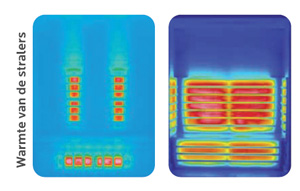

Illustration of a bus radiator (left) and plate radiator (right)
Tube radiators versus plate radiators
Tube radiators are infrared radiators with a straight shape or in a u, m or w shape. A reflector (a kind of silver mirror) is placed behind the radiator to reflect the infrared that is radiated back to the front towards the back. These infrared radiators provide very good infrared heat over the entire spine.
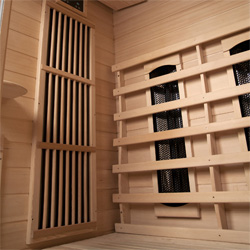

Image: On the left, one can see the plate radiator or also called carbon radiator.
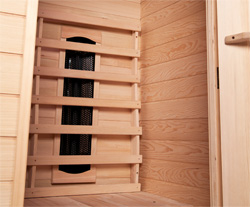

Incoloy, magnesium oxide, full spectrum and ceramic infrared emitters, are all examples of tube infrared emitters.
Plate radiators are infrared plates that distribute heat over a much larger surface area. As a result, neck and shoulders are treated very well. In addition, many users find this type of infrared heater the most pleasant. Research shows that when using this type of radiator for 30 minutes, the vast majority of users experience very positive therapeutic effects.
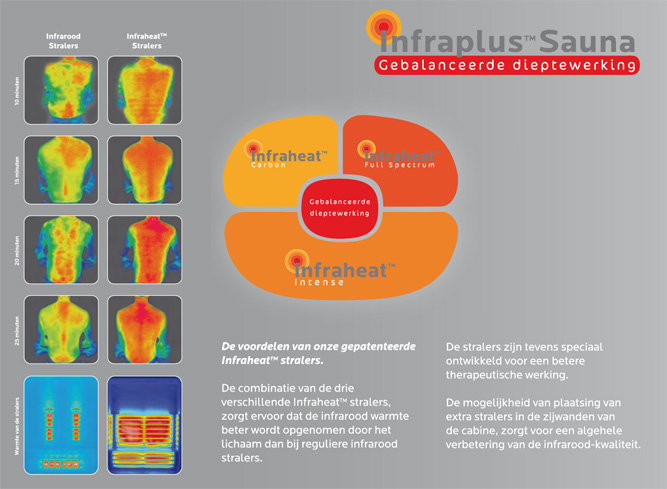

Combination of infrared emitters
Infraplus® Sauna makes it possible to combine three different emitters. A session in the infrared sauna can then look like this:
- 5-minute ir cabin preheating so that it has a comfortable temperature when one sits down in it.
- 10-minute seat for the full spectrum with part short wave.
- 10-minute seat for long wave with mid-wave.
- 10 minutes sitting in front of the plate radiator (also called carbon radiator). Whereas the other two radiant heaters deliver their infrared mainly on spine. The plate staler provides wonderful infrared on shoulders and neck.
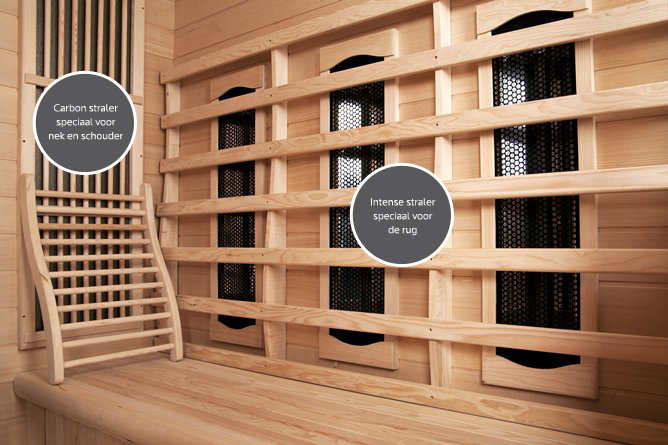

Zoals u gelezen heeft is het niet zo gemakkelijk te stellen welke infrarood straler het beste is. Dit hangt namelijk of van de type klachten en de gebruiker van de infrarood sauna. Bij een combinatie van verschillende stralers heeft u altijd meer mogelijkheden en betere resultaten.

